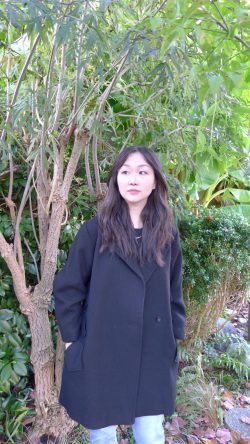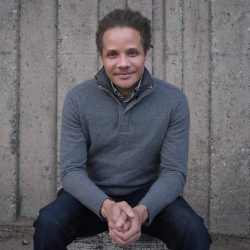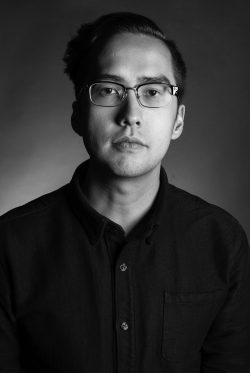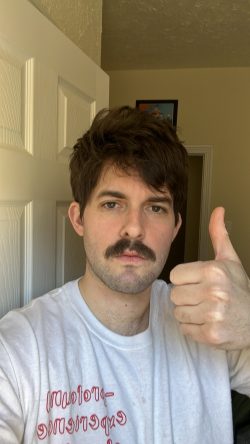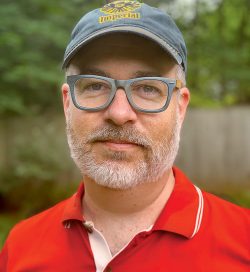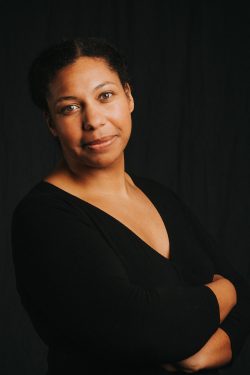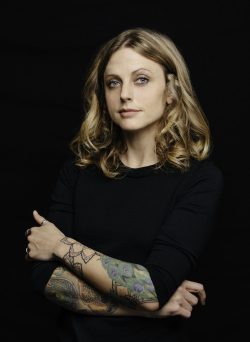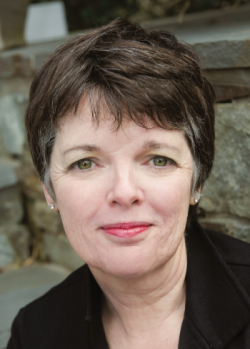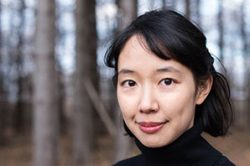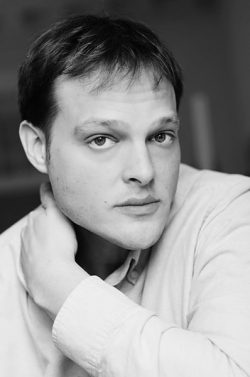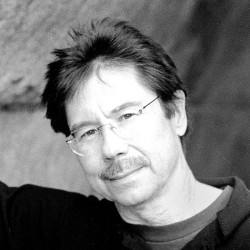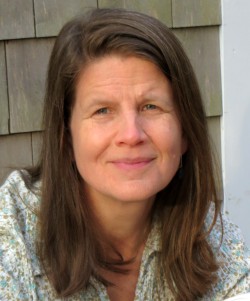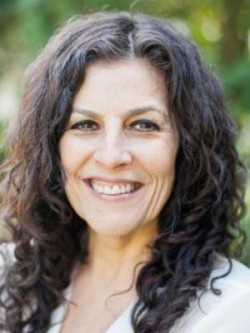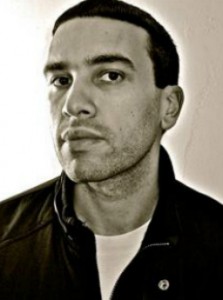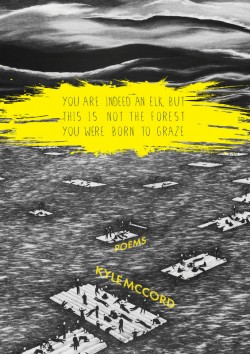Christine Lai grew up in Canada and lived in England for six years during graduate studies. She holds a PhD in English Literature from University College London. Landscapes was shortlisted for the inaugural Novel Prize. Christine currently lives in Vancouver.
In Lai’s interview with Nikki Barnhart of The Journal, they discuss art and memory in the age of environmental collapse.
The novel’s unique structure comprises Penelope’s diary entries, interspersed with periodic catalog notes; essays on art history; and occasional chapters told from the third-person perspective of Julian, the man who committed a violent act against Penelope years before. How did you decide on this particular structure to tell this story? Did you always envision the story to be told in such a multifaceted way?
Thanks for the great questions!
I’ve always wanted a hybrid text, but I didn’t decide on this current structure until later in the writing process. So originally the book was divided into half—the first half was Penelope’s perspective, and the second half was Julian’s. But I ended up cutting everything into fragments, and interspersing them. The diary form came first. I did try a very early draft where it was a third-person narrative for Penelope’s section, but I felt like something was missing—it didn’t feel quite right, so I switched to the diary and the first-person voice, and that was the right fit. I decided to keep Julian’s section in the third person in order to juxtapose the two voices, and the sections are written in slightly different styles to highlight the differences between these two characters. The art essays were written separately—I wanted to add texture to the text, and also to give Penelope a different voice, because the style she uses in the diary entries is very different from the style she uses for the art essays, which readers later find out, are also written by her. I kind of envisioned a triptych, divided into three parts, and all the different parts would speak to one another, with motifs that repeat across the different sections. I wanted a text that was layered, as opposed to linear and straightforward.
So Julian’s perspective was always a part of the plan? I find it so interesting that we get his point-of-view as well.
Yeah, definitely. But the nature of their relationship was not something that was there at the beginning—the violent aspect. That came later. I came across this painting by Turner—which kind of leads into your next question!—The Rape of Proserpine, inspired by the Greek myths. In the middle of the painting, you see this ruinous structure in the background, and there is a barren tree in the foreground, and in one corner, you see Proserpine being dragged into the underworld. But her figure is very tiny, it’s barely visible, and what you see is mostly just the landscape with the ruins and the tree. That image led me to think about the relationships between different kinds of ruination, and that gave me Penelope’s backstory, as it were. Initially, it was just her in this house, archiving items, and her relationship with Julian did not have that violent element.
Penelope adores the art of English Romantic painter J.M.W Turner, and his works figure prominently in the novel. I’m wondering if Turner also holds particular significance to you as well—was his work an inspiration for the novel, or did his art figure in while it was already in progress?
I guess both! His work is definitely an inspiration for parts of the novel, but I referred to his works throughout. The central painting, “A View on the Seine” is actually fictional—it doesn’t really exist but it’s based on a couple of real paintings that he did. My Canadian editor told me she kept Googling it, and said, “This painting doesn’t exist!” And I replied, “Yeah, I’m sorry, I should have mentioned that!” She went on this wild goose chase trying to find this image, but I used a fictional painting because I was worried about potential legal issues, as I was playing with the provenance of the painting. The fictional painting is based on a couple of paintings and sketches Turner did do of the Seine—but I was interested in that particular spot, where the two rivers are coming together to create this confluence, because I think the confluence as a metaphor is very interesting, and says a lot about forces clashing and things being irreconcilable. That’s why I wanted to use that particular geographic location. Turner was a part of my PhD so I’ve been thinking about his works for a long time, and I’ve always been drawn to his paintings when I saw them at the Tate. I just thought they were really mesmerizing, and I love the fact that he almost presaged Impressionism even though he is not as widely known as someone like Monet, but he was painting atmosphere in a particular way years before Monet was doing something very similar.
This novel is truly an art lover’s paradise: a bevy of references to art throughout history are intricately woven throughout the story. I wonder if you could speak a bit about the research process for writing the book. Were there artworks you knew you wanted to feature into it from the beginning, or was it a more organic process of discovering connections as you went along?
I think a bit of both! It was definitely research-intensive, if you look at the notes in the back of the book. I’m so glad they allowed me to print the notes, since they do take up a lot of space. Aside from the Turner, I wanted to look at other works that represent women and the Turner kind of led me to a lot of these works. I read books by feminist art historians—I’m incredibly indebted to them, I think they’ve done such a tremendous job doing this research and starting this conversation about the representation of women, a subject which is still not frequently talked about. I think I mentioned in a few places that museums and galleries do not openly acknowledge the violent subject of a lot of these paintings. One exception is the Isabella Stewart Gardner Museum—they have the Titian [his painting, The Rape of Europa, featured in the novel], and two years ago they held an exhibition on Titian, and power and women in art, where they talked openly about the subject of this series of paintings. I think if more museums and galleries were to educate the public, it would enrich our experience of the artworks. I don’t think that it diminishes the beauty of the works, it just adds this extra layer, and makes these works more relevant to our age. But maybe that’s controversial, because I’ve spoken to friends who love art and people who are like, “you shouldn’t look at art through this lens, you shouldn’t ruin our experience of artworks.” I’m not sure I agree with that viewpoint. As I was doing the research I came across more paintings [dealing with a similar subject matter], and once I began looking at art through that lens it became impossible to see them any other way. Nowadays if I’m at a gallery or museum, I do still find myself seeing that aspect of paintings. Some of the artworks included in the novel I’ve actually seen in person, before I started thinking about these ideas—I’ve been to Florence, I’ve seen the Giambologna [The Rape of the Sabine Women, referenced in the novel] and the Cellini sculptures [Perseus With the Head of Medusa, referenced in the novel], and I don’t remember being struck by them in that way. I remember being in awe of their beauty and the artists’ mastery of the materials. Now that I see them in this light, it just completely changed how I relate to these artworks. So it was kind of organic from that point on, and there were artworks that I had cut from the manuscript just because it was getting a bit long!
Penelope states that she has “felt possessive of art,” in particular of Turner’s works: “I felt I possessed him in a way no one else could.” In the eyes of her partner Aidan, her attachment to Turner is “unjustified” because she does not have a personal relationship with him—because he is a “stranger.” However, to me, Penelope’s deep affinity and even possessiveness to art and a particular artist was incredibly relatable, as I’m sure it is to most others who have ever loved any type of art. Is there an artist you feel this attachment towards? Why do you think we respond with feelings of possessiveness to the art that moves us most deeply?
That’s such an interesting question. For one, because art is always entangled with ideas about property and possession, because it is a visible form of capital. I read a lot of John Berger’s writings in which he talks about art and property—there’s this drive to possess and stake a claim on something that is beautiful, and I think we see that in our relations to other things, to nature, for example. In terms of artists I felt attached to—I did feel that attachment when I was young. I loved van Gogh as a teenager; I was obsessed with van Gogh. Not just because of his paintings but also because of his letters—he was a phenomenal writer. I loved reading his letters and looking at the paintings and his use of colors, but because van Gogh is possibly the most popular artist in history, I wanted to know him in a way that others didn’t, which is perhaps a really silly teenage thing to think—
But I totally get it!
Yeah! I feel like by reading these letters, by studying his words, I understood his work on a deeper level, and Penelope shares a bit of that with regards to Turner’s work— through this daily interaction with a work, you develop a kind of intimacy with it that you otherwise wouldn’t. And I definitely felt this attachment to writers. I studied the Romantics, so Percy Bysshe Shelley and Mary Shelley were my literary heroes and I was very obsessed with their work—I read everything and felt like, again, that sense of possession through knowledge, through understanding.
That is all definitely expressed so powerfully in the book, as well as that idea of possessing beauty, even if it’s a futile pursuit—I felt like that came through so strongly. Similarly, I’m interested in the particular process of creating such an ekphrastic work. It is a challenge to convey images and visuals through words—it’s almost like an act of translation—but you render all of the references to art featured in Landscapes so vividly and clearly. Can you talk a bit about that process? Did you have any models in helping you craft these sections?
Definitely Sebald, and John Berger is another one I read really early on—I think I read his Ways of Seeing when I was undergrad, and that really revolutionized the way I saw art. Writers like Kate Zambreno who write a lot about art, and Teju Cole…I always refer to their works. Also art historians and art critics—I read a lot of art criticism, and they have this amazing way of capturing something that seems to really challenge language. There’s this great quote from Orhan Pamuk, in The Naïve and Sentimental Novelist—he writes about how novelists are secretly envious of visual artists.
I totally think so—I mean, I feel that.
Exactly, me too! You know, I think if I got to start all over again, maybe I’d become a painter. [laughs]. So yeah, [Pamuk] said that the process of writing always begins with visualization, visualizing the space in which the character lives, and writing is translating that into text. But because of that process of translation, we’re removed from the visual image, whereas the visual artist is able to capture that directly. There is this kind of directness that writing does not allow. So I think that’s very true—I feel very envious!
One of the things I found most striking in this novel is its particular treatment of memory, and how archives and the act of conservation are perhaps the closest we can get to making it tangible. I’m wondering what archives mean to you—in the broadest sense, how might you archive your own life? Do you think of writing as a type of archive?
I definitely think writing is a type of archive, and the archive that Penelope keeps in the book is somehow parallel to the diary. There’s this great essay by Italo Calvino called “Collection of Sand”where he writes about the correspondence between diary-keeping and keeping a collection—both are ways of imposing order on the chaos of life, putting everything into a kind of neat series. That’s definitely part of Penelope’s engagement with the archive items, and like you said, archives are about preservation, but at the same time, archives are almost never complete. There’s also something almost illogical about the way certain archives are formed—you often find random items in archives. I’ve done some archival research when I was in graduate school, and there’s an element of accident or chance—you come across something that you did not expect to see, and the archive just seems like a collection of very eclectic items. And that’s very fascinating. There’s this great book by the British artist, Tacita Dean, called Monet Hates Me. It’s based on her research at the Getty Research Institute—she went into the archives and found these random items, then she photographed them and wrote text that went with each photograph. I thought it was really fascinating; she had this concept of objective chance as a research tool, this idea of just letting yourself encounter certain images or objects in a very serendipitous way and letting those encounters influence you and the projects you’re working on. So that was something that I used, both as a composition method for the book, but also as part of Penelope as character—all the items she encounters are linked to her memories, to particular moments in her past.
Lastly, I’d love to wrap up by asking about what
art you’re loving right now: visual art, books, music, movies? I want to hear
about all of it!
I actually wrote down a list; there are
so many things! Visual art: so I love Tacita Dean. I’m working on a new project
that’s more to do with photography, and I’m looking at a lot of photographers,
including Dean and the Italian photographer, Luigi Ghirri—absolutely sublime
photographs. There’s this amazing Substrack called “Tender Photo,” by the
writer Emmanuel Iduma. It’s just fantastic—it pairs text with photographs by
Nigerian photographers and Iduma invites photographers to submit their work to
the Substack. He also invites other writers to respond to photographs in his
collection. I love the sculptor Ruth Asawa, and I’m going to the exhibition at
the Whitney next week. I think it’s just opening this week, and I’m really
excited—I’ve always loved her sculptures, so I’m really looking forward to
that! In terms of books—um, a lot of books! It’s really hard to choose, you
know, top books of the year or favorite books. I read Rombo by Esther Kinsky—an NYRB publication from earlier in the
year, and that was incredible. It addresses memory and catastrophe, and is
written in this kind of fragmentary form which I love. There’s a new short
story collection coming out from Two Dollar Radio, by Bennett Sims, called Other Minds and Other Stories. I don’t
read a lot of short story collections, but this was just mind-blowing, I
thought it was really, really amazing. Music…I’ve been obsessed with Max
Richter’s rendition of Vivaldi’s Four
Seasons. I listen to a lot of classical music when I write, because I don’t
like anything with lyrics—the lyrics are a bit distracting, I start to listen
to the words and the meaning…so I just prefer instrumental. And I’m trying to
think of movies…there are so many movies! I’ve been watching a lot of Taiwanese
New Cinema from the 1980s, because I’m working on an essay about Taipei, which
is where I was born, so I’ve been just watching cinema from that era, looking
at the way the cityscape is represented.
Thank you so much Christine!
Thank you so much for the questions! It was really lovely chatting with you.

